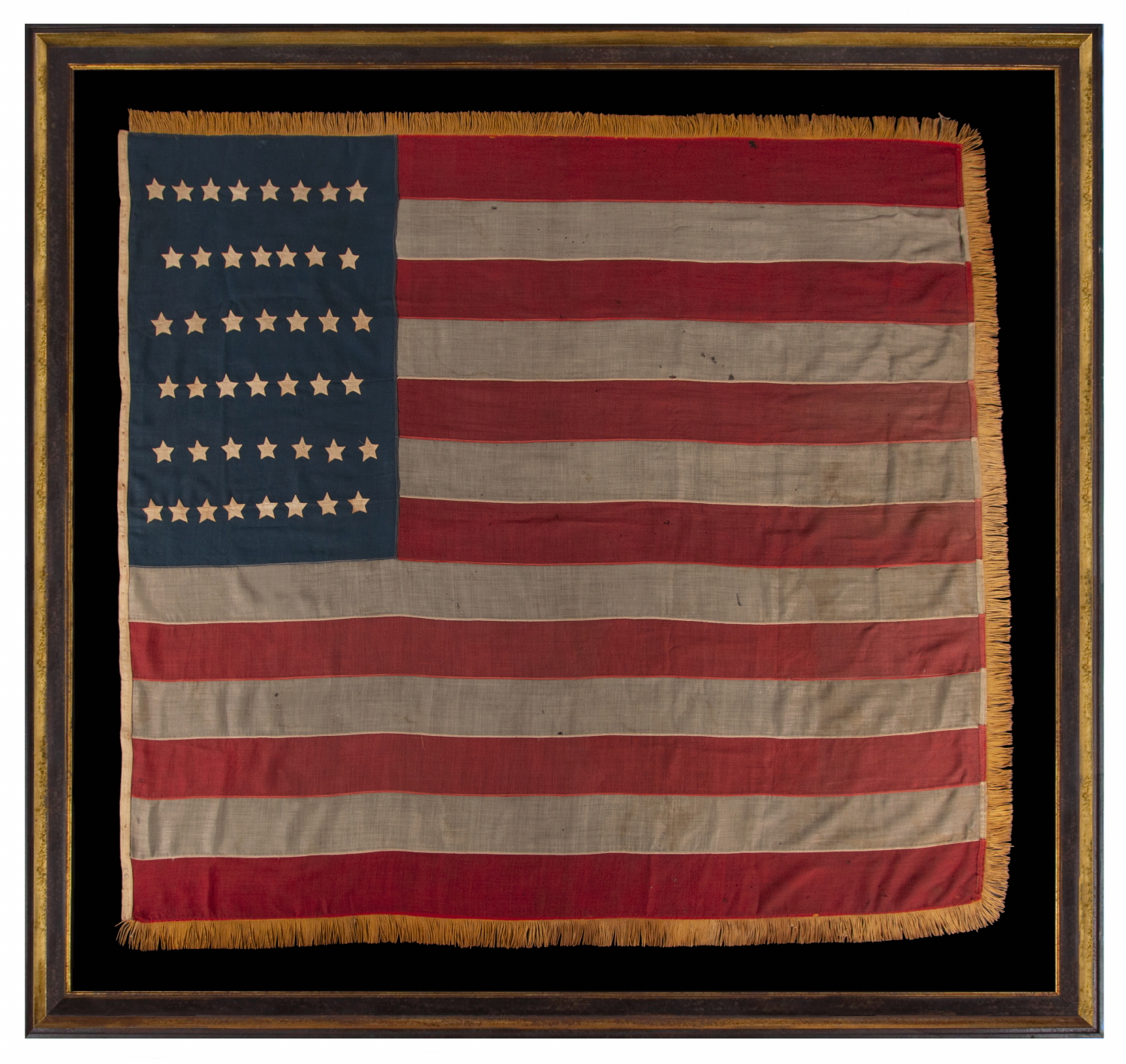
| |
44 STARS ON AN ANTIQUE AMERICAN FLAG WITH AN EXAGGERATEDLY TALL AND NARROW CANTON, ON A U.S. ARMY REGULATION BATTLE FLAG MADE DURING THE LATE INDIAN WARS PERIOD, REFLECTS THE RECENT ADDITION OF WYOMING TO THE UNION, 1890-1896 |
|
| Available: |
Sold |
| Frame Size (H x L): |
Approx. 92" x 96" |
| Flag Size (H x L): |
78" x 83" |
|
| Description....: |
|
This rare and visually interesting 44 star American national flag is a United States Army battle colors of the late Indian Wars period. At approximately 74" x 81", plus the fringe, the measurements are just a bit larger than what Army regulations specified for the flags of field regiments, including both infantry and artillery. While 72" on the hoist x 78" on the fly was standard, there was a great deal of variation when it came to actual production of military flags during the 19th century.
Note how the proportions of the flag are near-to-square. This sort of design was favorable for ground use, because it allowed the flag to be as large as possible, in order to effective as a signal, yet at the same time not drag on the ground. When raised on a staff, it is the measurement on the bias that determines this factor. The square shape maximized the surface area of the textile when hand-carried.
Note also how the blue is extremely tall and narrow and thus completely opposite of what might expect on a modern flag. This aspect was sometimes encountered in Stars & Stripes battle flags of the 19th century and adds a substantial amount of visual impact to their presentation.
The 44th state, Wyoming, gained statehood on July 10th, 1890. Many flag makers would have began to add a 44th star to their flags on or before that day, and the 44 star flag would have generally seen use until the addition of Utah in 1896.
The stars of the flag are arranged in lineal rows of 8-7-7-7-7-8. It is of interest to note that the four rows of 7 are not uniform, as one might expect, but are instead crowded and stretched in an accordion-like fashion. This is extremely peculiar and something I cannot recall having encountered previously. The arrangement is done in such a way that the initial row of 8 stars is almost justified with the 3rd and 5th. The last row of 8, though similar in width to the row of 7 above it, is offset toward the hoist, which continues the zigzagging profile along the fly end of the configuration. Despite the lack of uniformity in the last row, the pattern works visually.
Because there was no official way to arrange the stars on the American flag until 1912, the pattern was left up to the maker, or to whomever commissioned the making of a flag. As the 19th century came to a close, both flag construction and design became increasingly uniform. Dynamic and unusual star configurations basically disappeared following our nation's 100-year anniversary of independence in 1876, along with many of the eccentricities that make early flags appealing to collectors. Due to these facts, exceptional examples in the 44 star count are not frequently encountered. At the same time, U.S. Army regulation battle flags of this period are rare. The combination of such an exaggeratedly tall canton on a 44 star, near-to-square, military format flag, made for an especially interesting find.
Construction: The stripes and canton of the flag are made of wool bunting that has been joined with treadle stitching. The stars of the flag are made of cotton and are double-appliquéd (applied to both sides of the flag) with a lineal treadle stitch. There is a narrow, plain weave cotton binding along the hoist. This provided reinforcement so that the flag could be affixed to a wooden staff with metal tacks. A twisted, gold fringe runs the perimeter on three sides.
Mounting: The flag was mounted and framed within our own conservation department, which is led by expert staff. We take great care in the mounting and preservation of flags and have framed thousands of examples. The flag has been flat-lined with hand-stitching to 100% natural fabrics throughout for support, on every seam and throughout the star field. It will then be hand-stitched to 100% cotton twill, black in color, that has been washed and treated for color fastness. The mount was then placed in a black-painted, hand-gilded and distressed Italian molding. The glazing is U.V. protective acrylic.
Condition: There is minor mothing in limited areas. There is minor to modest fading in the red stripes, the most significant of which is at the fly end in the lowest 5 stripes. There is modest soiling and water staining in the white fabrics, the most significant of which is in the lowest 4 white stripes, towards the fly end from center. There are tiny tack holes along the hoist, with associated rust stains, where metal tacks once held it to a wooden staff. There are minor losses and imperfections in the fringe, accompanied by minor to modest soiling and modest fading in some areas. Many of my clients prefer early flags to show their age and history of use. |
|
|
|
| Collector Level: |
Advanced Collectors and the Person with Everything |
|
| Flag Type: |
Sewn flag |
|
| Star Count: |
44 |
|
| Earliest Date of Origin: |
1890 |
|
| Latest Date of Origin: |
1896 |
|
| State/Affiliation: |
Wyoming |
|
| War Association: |
1866-1890 Indian Wars |
|
| Price: |
SOLD |
|
| |
Views: 416 |
|
|
|

